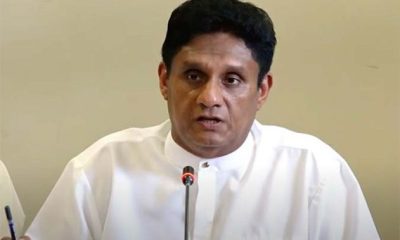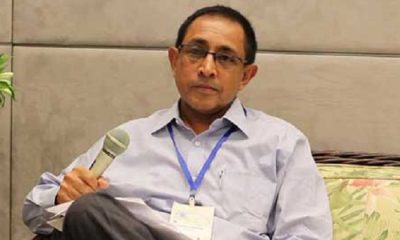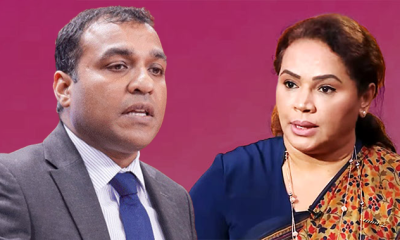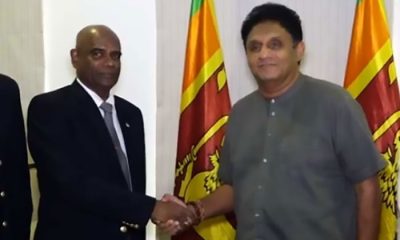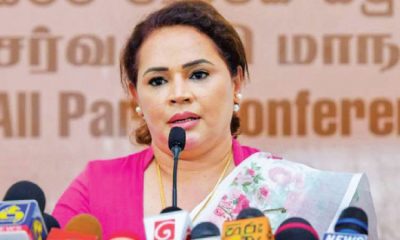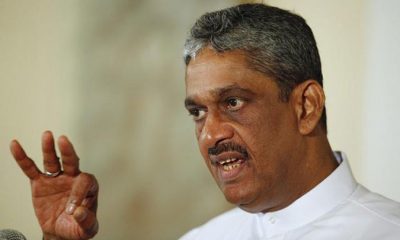Features
The SJB’s trust deficit and the JVP-NPP’s strategy
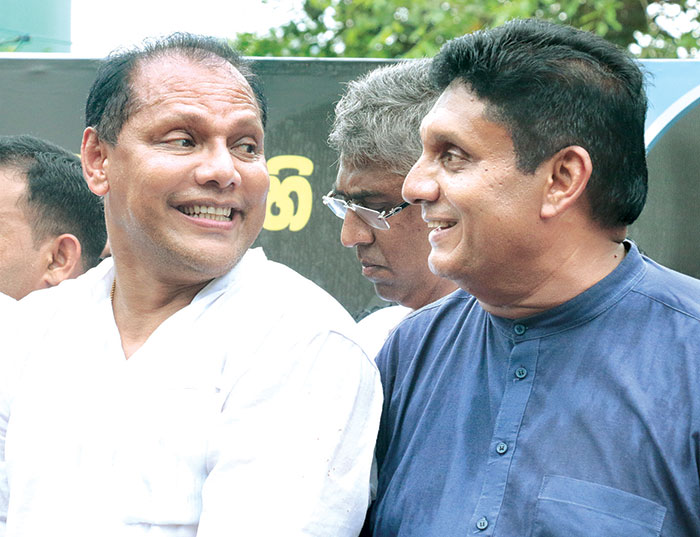
By Uditha Devapriya

The aragalaya that lasted from February to somewhere in August showed two things: the people’s anger at the regime and the people’s rage against the system. The two are clean different. While a considerable section of the protesters wanted Gotabaya Rajapaksa out, a not inconsiderable second layer used these calls to campaign against the government: hence the interchangeable use of “regime change” and “system change.”
Given this, people should be forgiven for thinking the protests were confused, disjointed and unfocused, because they were exactly that. Laudable as their goals were, they soon deteriorated into a confused morass of rage, anger, and frustration.
The distinction between regime and State is one of the most profound in political science. Sri Lanka’s liberals and left-liberals, not to mention anarchists, tend to confuse and conflate the two. A State exists above, and beyond, a regime. A regime exists well below it, and is in fact subservient to it. If your call to displace a regime gets mixed up in calls to displace the State, then a regime, however unpopular, will find it very easy to make a comeback, on the pretext that protesters are seeking to overthrow an entire political system and with it the last vestiges of law and order. This is precisely what happened on July 13 and 14, when the FSP, followed by the JVP-NPP, asked people to walk into parliament. Their intention may or may not have been to overthrow the legislature, but people thought so.
This in turn activated the more liberal and conservative elements in the aragalaya. Almost immediately after the likes of Kumar Gunaratnam and Sunil Handunneti mobilised crowds at parliament, these groups sprang up on social media, urging people not to go and be hoodwinked by socialist parties. What these groups forgot, in their outcries, was that it had been these socialist elements – or those parading themselves as such – which had led and mobilised the protests since May. Prime among these groups, of course, was the FSP allied IUSF. The IUSF’s long march to Galle Face Green was cheered by a hitherto politically inert middle-class, in particular the youth. It is these same sections that are today castigating the IUSF and the FSP over allegations of ragging at universities.
In other words, the honeymoon is over, even if temporarily. The government has seen it fit to act against protesters and it sees the spate of arrests it has been unleashing since last month as a means of securing, if not the country, then at least Colombo. The same middle-class that hailed them as heroes are no longer bothered. This is natural, and it speaks more about the IUSF’s strategic error of relying on them than about the class preferences of these milieus. Related to this, I would say, is the IUSF’s, JVP-NPP’s, and of course FSP’s tendency to mix up State and regime, which has led these groups to commit two major blunders: to cast themselves as the only political choices in the country, and to alienate Opposition parties which can be made use of in a wider anti-government movement.
I think the November 2 protest showed these tendencies well. While the SJB, the de facto and de jure Opposition in the country, entered into an alliance of sorts with the FSP – and hence FSP allied groups – SJB MPs who entered the protests were not viewed favourably by many of the protesters themselves. Nuzly Hameem, who I believe is one of the more sincere protesters in that crowd, was blunt about Sajith Premadasa: “He simply ran away!” When an SJB official rose up to Premadasa’s defence – as he should – by arguing that Premadasa was afraid of the police attacking demonstrators, Hameem quickly countered: “Irony is such that Opposition leader run away leaving the protesters behind scared that oppression would take place where the main slogan of the protest is ‘Stop Oppression’.”
The protests caught much attention, here and abroad. The international media was much more sympathetic to their demands. The local media, by contrast, either ignored them or demonised them. One leading newspaper highlighted Premadasa’s desertion, in effect questioning his credibility. The protesters themselves, on social media, voiced their anger at Premadasa, more or less agreeing with the same media that marginalised their campaign. I think this shows the SJB’s trust deficit, a deficit compounded if not widened by Premadasa’s actions during the May 9 debacle, and his unwillingness – critiqued even by analysts like Dr Dayan Jayatilleka – to take on the premiership when it was offered to him.
At the same time, these developments have disenchanted sections of the Left opposition. What the FSP thought of Premadasa’s actions last Wednesday we may never know. But we know what the JVP-NPP thought. They refused to join the protests. Justifying his party’s line, MP Wasantha Samarasinghe contended that those taking part in them were more or less siding with the government. One of the demonstrators’ many calls was the abolition of the Prevention of Terrorism Act (PTA). MP Samarasinghe point-blank observed that such calls diverted attention from other issues, and that those taking up cudgels against the PTA were following the government’s agenda. By making this case for his party’s decision not to take part, Samarasinghe thus effectively distanced it from the FSP and the SJB.
I think I understand the JVP-NPP’s argument, whataboutist as it may be. At a time of a deepening economic and social crisis, the government is using the PTA to crack down on dissent. MP Samarasinghe and the JVP-NPP may be thinking that if the campaign against the government focuses solely, or mainly, on the PTA, it will embolden the government, or the State, to portray protesters as terrorists and fellow travellers. Over the last few weeks the government has instituted legal action against several aragalistas and this has enabled it to depict the latter as extremists. Samarasinghe’s argument is that by focusing on the PTA, instead of the gross incompetence that continues to wreak havoc on the economy, these protests will make it easier for the government to suppress dissent.
This is the more complex explanation. The simpler explanation, of course, is that the JVP-NPP does not want to take part in any campaign organised by not one, but two, of its bete noires. It does not like the FSP and it has so far resisted any attempt at forging an alliance with that outfit. It does not like Sajith Premadasa, if at all for his sin of being his father’s son. Lately it has badmouthed his party, calling it no better than the SLPP – invoking, of course, the late Mangala Samaraweera’s “two sides, same coin” argument. The JVP-NPP sees itself as the superior of these two formations and for that reason it does not wish to enter into any alliance with them. Though Premadasa himself has tried to invite them, and has made many overtures to this end during the last two years, he has failed.
In politics, it is perfectly possible to be correct and wrong at the same time. The JVP-NPP is correct in its characterisation of the SJB. Not because the SJB hasn’t tried, but because it hasn’t tried hard enough. Sajith Premadasa’s speech against the recent Budget showed that the SJB wants to be seen as following a different economic paradigm. Yet the blowback against the party by centre-right, right-wing, and neoliberal outfits and think-tanks based in Colombo has pushed the party’s stalwarts, like Harsha de Silva and Eran Wickramaratne, to make statements at odds with Premadasa’s speech: one of them has come out in support of Ranil Wickremesinghe’s policies. These elements are deeply conservative and neoliberal in their outlook. The JVP-NPP cannot be faulted for calling them out on this.
The JVP-NPP is wrong, in my view, in where it wants to go with this diagnosis. Any sensible political formation pitted against an overbearing regime must value what Mao characterised as the broadest possible alliance. In no revolution have revolutionary elements all come together with a consensus on every issue and problem. Latin America is seeing a resurgence of the Pink Tide precisely because the left and centre-left have chosen not to walk it alone. This has won these parties some censure from the dogmatist Left: the editors of the World Socialist Web Site, for instance, have poured scorn on the Workers’ Party in Brazil and its mobilisation of leftist forces by calling the latter elements “pseudo-left.” The WSWS calls the JVP-NPP “pseudo-left” too: a charge the party may not agree with.
But I digress here. My point is that the JVP-NPP cannot isolate itself from the mainstream Opposition. At the same time, it cannot allow itself to be co-opted by the mainstream. The Latin American Pink Tide analogy loses ground when you consider that elements within the SJB, or what I’d like to call the Ranilist faction, are much more to the right than the centre-left and liberal elements which sided with Lula da Silva’s party in Brazil. The WSWS may be wrong in terming these formations, and their supporters, “pseudo-left”, but this is a label that can be applied to the SJB’s recent attempts at shifting to the left. The recent protests, in that sense, showed both the strengths and the weaknesses of the Left elements in the aragalaya. Unless they come up with an alliance with other parties, and unless those other parties free themselves from their neoliberal past, the only time we’ll see a vibrant protest movement here is when the country runs out of fuel, gas, and electricity.
The writer is an international relations analyst, researcher, and columnist who can be reached at udakdev1@gmail.com
Features
The heart-friendly health minister

by Dr Gotabhya Ranasinghe
Senior Consultant Cardiologist
National Hospital Sri Lanka
When we sought a meeting with Hon Dr. Ramesh Pathirana, Minister of Health, he graciously cleared his busy schedule to accommodate us. Renowned for his attentive listening and deep understanding, Minister Pathirana is dedicated to advancing the health sector. His openness and transparency exemplify the qualities of an exemplary politician and minister.
Dr. Palitha Mahipala, the current Health Secretary, demonstrates both commendable enthusiasm and unwavering support. This combination of attributes makes him a highly compatible colleague for the esteemed Minister of Health.
Our discussion centered on a project that has been in the works for the past 30 years, one that no other minister had managed to advance.
Minister Pathirana, however, recognized the project’s significance and its potential to revolutionize care for heart patients.
The project involves the construction of a state-of-the-art facility at the premises of the National Hospital Colombo. The project’s location within the premises of the National Hospital underscores its importance and relevance to the healthcare infrastructure of the nation.
This facility will include a cardiology building and a tertiary care center, equipped with the latest technology to handle and treat all types of heart-related conditions and surgeries.
Securing funding was a major milestone for this initiative. Minister Pathirana successfully obtained approval for a $40 billion loan from the Asian Development Bank. With the funding in place, the foundation stone is scheduled to be laid in September this year, and construction will begin in January 2025.
This project guarantees a consistent and uninterrupted supply of stents and related medications for heart patients. As a result, patients will have timely access to essential medical supplies during their treatment and recovery. By securing these critical resources, the project aims to enhance patient outcomes, minimize treatment delays, and maintain the highest standards of cardiac care.
Upon its fruition, this monumental building will serve as a beacon of hope and healing, symbolizing the unwavering dedication to improving patient outcomes and fostering a healthier society.We anticipate a future marked by significant progress and positive outcomes in Sri Lanka’s cardiovascular treatment landscape within the foreseeable timeframe.
Features
A LOVING TRIBUTE TO JESUIT FR. ALOYSIUS PIERIS ON HIS 90th BIRTHDAY

by Fr. Emmanuel Fernando, OMI
Jesuit Fr. Aloysius Pieris (affectionately called Fr. Aloy) celebrated his 90th birthday on April 9, 2024 and I, as the editor of our Oblate Journal, THE MISSIONARY OBLATE had gone to press by that time. Immediately I decided to publish an article, appreciating the untiring selfless services he continues to offer for inter-Faith dialogue, the renewal of the Catholic Church, his concern for the poor and the suffering Sri Lankan masses and to me, the present writer.
It was in 1988, when I was appointed Director of the Oblate Scholastics at Ampitiya by the then Oblate Provincial Fr. Anselm Silva, that I came to know Fr. Aloy more closely. Knowing well his expertise in matters spiritual, theological, Indological and pastoral, and with the collaborative spirit of my companion-formators, our Oblate Scholastics were sent to Tulana, the Research and Encounter Centre, Kelaniya, of which he is the Founder-Director, for ‘exposure-programmes’ on matters spiritual, biblical, theological and pastoral. Some of these dimensions according to my view and that of my companion-formators, were not available at the National Seminary, Ampitiya.
Ever since that time, our Oblate formators/ accompaniers at the Oblate Scholasticate, Ampitiya , have continued to send our Oblate Scholastics to Tulana Centre for deepening their insights and convictions regarding matters needed to serve the people in today’s context. Fr. Aloy also had tried very enthusiastically with the Oblate team headed by Frs. Oswald Firth and Clement Waidyasekara to begin a Theologate, directed by the Religious Congregations in Sri Lanka, for the contextual formation/ accompaniment of their members. It should very well be a desired goal of the Leaders / Provincials of the Religious Congregations.
Besides being a formator/accompanier at the Oblate Scholasticate, I was entrusted also with the task of editing and publishing our Oblate journal, ‘The Missionary Oblate’. To maintain the quality of the journal I continue to depend on Fr. Aloy for his thought-provoking and stimulating articles on Biblical Spirituality, Biblical Theology and Ecclesiology. I am very grateful to him for his generous assistance. Of late, his writings on renewal of the Church, initiated by Pope St. John XX111 and continued by Pope Francis through the Synodal path, published in our Oblate journal, enable our readers to focus their attention also on the needed renewal in the Catholic Church in Sri Lanka. Fr. Aloy appreciated very much the Synodal path adopted by the Jesuit Pope Francis for the renewal of the Church, rooted very much on prayerful discernment. In my Religious and presbyteral life, Fr.Aloy continues to be my spiritual animator / guide and ongoing formator / acccompanier.
Fr. Aloysius Pieris, BA Hons (Lond), LPh (SHC, India), STL (PFT, Naples), PhD (SLU/VC), ThD (Tilburg), D.Ltt (KU), has been one of the eminent Asian theologians well recognized internationally and one who has lectured and held visiting chairs in many universities both in the West and in the East. Many members of Religious Congregations from Asian countries have benefited from his lectures and guidance in the East Asian Pastoral Institute (EAPI) in Manila, Philippines. He had been a Theologian consulted by the Federation of Asian Bishops’ Conferences for many years. During his professorship at the Gregorian University in Rome, he was called to be a member of a special group of advisers on other religions consulted by Pope Paul VI.
Fr. Aloy is the author of more than 30 books and well over 500 Research Papers. Some of his books and articles have been translated and published in several countries. Among those books, one can find the following: 1) The Genesis of an Asian Theology of Liberation (An Autobiographical Excursus on the Art of Theologising in Asia, 2) An Asian Theology of Liberation, 3) Providential Timeliness of Vatican 11 (a long-overdue halt to a scandalous millennium, 4) Give Vatican 11 a chance, 5) Leadership in the Church, 6) Relishing our faith in working for justice (Themes for study and discussion), 7) A Message meant mainly, not exclusively for Jesuits (Background information necessary for helping Francis renew the Church), 8) Lent in Lanka (Reflections and Resolutions, 9) Love meets wisdom (A Christian Experience of Buddhism, 10) Fire and Water 11) God’s Reign for God’s poor, 12) Our Unhiddden Agenda (How we Jesuits work, pray and form our men). He is also the Editor of two journals, Vagdevi, Journal of Religious Reflection and Dialogue, New Series.
Fr. Aloy has a BA in Pali and Sanskrit from the University of London and a Ph.D in Buddhist Philosophy from the University of Sri Lankan, Vidyodaya Campus. On Nov. 23, 2019, he was awarded the prestigious honorary Doctorate of Literature (D.Litt) by the Chancellor of the University of Kelaniya, the Most Venerable Welamitiyawe Dharmakirthi Sri Kusala Dhamma Thera.
Fr. Aloy continues to be a promoter of Gospel values and virtues. Justice as a constitutive dimension of love and social concern for the downtrodden masses are very much noted in his life and work. He had very much appreciated the commitment of the late Fr. Joseph (Joe) Fernando, the National Director of the Social and Economic Centre (SEDEC) for the poor.
In Sri Lanka, a few religious Congregations – the Good Shepherd Sisters, the Christian Brothers, the Marist Brothers and the Oblates – have invited him to animate their members especially during their Provincial Congresses, Chapters and International Conferences. The mainline Christian Churches also have sought his advice and followed his seminars. I, for one, regret very much, that the Sri Lankan authorities of the Catholic Church –today’s Hierarchy—- have not sought Fr.
Aloy’s expertise for the renewal of the Catholic Church in Sri Lanka and thus have not benefited from the immense store of wisdom and insight that he can offer to our local Church while the Sri Lankan bishops who governed the Catholic church in the immediate aftermath of the Second Vatican Council (Edmund Fernando OMI, Anthony de Saram, Leo Nanayakkara OSB, Frank Marcus Fernando, Paul Perera,) visited him and consulted him on many matters. Among the Tamil Bishops, Bishop Rayappu Joseph was keeping close contact with him and Bishop J. Deogupillai hosted him and his team visiting him after the horrible Black July massacre of Tamils.
Features
A fairy tale, success or debacle

Sri Lanka-Singapore Free Trade Agreement
By Gomi Senadhira
senadhiragomi@gmail.com
“You might tell fairy tales, but the progress of a country cannot be achieved through such narratives. A country cannot be developed by making false promises. The country moved backward because of the electoral promises made by political parties throughout time. We have witnessed that the ultimate result of this is the country becoming bankrupt. Unfortunately, many segments of the population have not come to realize this yet.” – President Ranil Wickremesinghe, 2024 Budget speech
Any Sri Lankan would agree with the above words of President Wickremesinghe on the false promises our politicians and officials make and the fairy tales they narrate which bankrupted this country. So, to understand this, let’s look at one such fairy tale with lots of false promises; Ranil Wickremesinghe’s greatest achievement in the area of international trade and investment promotion during the Yahapalana period, Sri Lanka-Singapore Free Trade Agreement (SLSFTA).
It is appropriate and timely to do it now as Finance Minister Wickremesinghe has just presented to parliament a bill on the National Policy on Economic Transformation which includes the establishment of an Office for International Trade and the Sri Lanka Institute of Economics and International Trade.
Was SLSFTA a “Cleverly negotiated Free Trade Agreement” as stated by the (former) Minister of Development Strategies and International Trade Malik Samarawickrama during the Parliamentary Debate on the SLSFTA in July 2018, or a colossal blunder covered up with lies, false promises, and fairy tales? After SLSFTA was signed there were a number of fairy tales published on this agreement by the Ministry of Development Strategies and International, Institute of Policy Studies, and others.
However, for this article, I would like to limit my comments to the speech by Minister Samarawickrama during the Parliamentary Debate, and the two most important areas in the agreement which were covered up with lies, fairy tales, and false promises, namely: revenue loss for Sri Lanka and Investment from Singapore. On the other important area, “Waste products dumping” I do not want to comment here as I have written extensively on the issue.
1. The revenue loss
During the Parliamentary Debate in July 2018, Minister Samarawickrama stated “…. let me reiterate that this FTA with Singapore has been very cleverly negotiated by us…. The liberalisation programme under this FTA has been carefully designed to have the least impact on domestic industry and revenue collection. We have included all revenue sensitive items in the negative list of items which will not be subject to removal of tariff. Therefore, 97.8% revenue from Customs duty is protected. Our tariff liberalisation will take place over a period of 12-15 years! In fact, the revenue earned through tariffs on goods imported from Singapore last year was Rs. 35 billion.
The revenue loss for over the next 15 years due to the FTA is only Rs. 733 million– which when annualised, on average, is just Rs. 51 million. That is just 0.14% per year! So anyone who claims the Singapore FTA causes revenue loss to the Government cannot do basic arithmetic! Mr. Speaker, in conclusion, I call on my fellow members of this House – don’t mislead the public with baseless criticism that is not grounded in facts. Don’t look at petty politics and use these issues for your own political survival.”
I was surprised to read the minister’s speech because an article published in January 2018 in “The Straits Times“, based on information released by the Singaporean Negotiators stated, “…. With the FTA, tariff savings for Singapore exports are estimated to hit $10 million annually“.
As the annual tariff savings (that is the revenue loss for Sri Lanka) calculated by the Singaporean Negotiators, Singaporean $ 10 million (Sri Lankan rupees 1,200 million in 2018) was way above the rupees’ 733 million revenue loss for 15 years estimated by the Sri Lankan negotiators, it was clear to any observer that one of the parties to the agreement had not done the basic arithmetic!
Six years later, according to a report published by “The Morning” newspaper, speaking at the Committee on Public Finance (COPF) on 7th May 2024, Mr Samarawickrama’s chief trade negotiator K.J. Weerasinghehad had admitted “…. that forecasted revenue loss for the Government of Sri Lanka through the Singapore FTA is Rs. 450 million in 2023 and Rs. 1.3 billion in 2024.”
If these numbers are correct, as tariff liberalisation under the SLSFTA has just started, we will pass Rs 2 billion very soon. Then, the question is how Sri Lanka’s trade negotiators made such a colossal blunder. Didn’t they do their basic arithmetic? If they didn’t know how to do basic arithmetic they should have at least done their basic readings. For example, the headline of the article published in The Straits Times in January 2018 was “Singapore, Sri Lanka sign FTA, annual savings of $10m expected”.
Anyway, as Sri Lanka’s chief negotiator reiterated at the COPF meeting that “…. since 99% of the tariffs in Singapore have zero rates of duty, Sri Lanka has agreed on 80% tariff liberalisation over a period of 15 years while expecting Singapore investments to address the imbalance in trade,” let’s turn towards investment.
Investment from Singapore
In July 2018, speaking during the Parliamentary Debate on the FTA this is what Minister Malik Samarawickrama stated on investment from Singapore, “Already, thanks to this FTA, in just the past two-and-a-half months since the agreement came into effect we have received a proposal from Singapore for investment amounting to $ 14.8 billion in an oil refinery for export of petroleum products. In addition, we have proposals for a steel manufacturing plant for exports ($ 1 billion investment), flour milling plant ($ 50 million), sugar refinery ($ 200 million). This adds up to more than $ 16.05 billion in the pipeline on these projects alone.
And all of these projects will create thousands of more jobs for our people. In principle approval has already been granted by the BOI and the investors are awaiting the release of land the environmental approvals to commence the project.
I request the Opposition and those with vested interests to change their narrow-minded thinking and join us to develop our country. We must always look at what is best for the whole community, not just the few who may oppose. We owe it to our people to courageously take decisions that will change their lives for the better.”
According to the media report I quoted earlier, speaking at the Committee on Public Finance (COPF) Chief Negotiator Weerasinghe has admitted that Sri Lanka was not happy with overall Singapore investments that have come in the past few years in return for the trade liberalisation under the Singapore-Sri Lanka Free Trade Agreement. He has added that between 2021 and 2023 the total investment from Singapore had been around $162 million!
What happened to those projects worth $16 billion negotiated, thanks to the SLSFTA, in just the two-and-a-half months after the agreement came into effect and approved by the BOI? I do not know about the steel manufacturing plant for exports ($ 1 billion investment), flour milling plant ($ 50 million) and sugar refinery ($ 200 million).
However, story of the multibillion-dollar investment in the Petroleum Refinery unfolded in a manner that would qualify it as the best fairy tale with false promises presented by our politicians and the officials, prior to 2019 elections.
Though many Sri Lankans got to know, through the media which repeatedly highlighted a plethora of issues surrounding the project and the questionable credentials of the Singaporean investor, the construction work on the Mirrijiwela Oil Refinery along with the cement factory began on the24th of March 2019 with a bang and Minister Ranil Wickremesinghe and his ministers along with the foreign and local dignitaries laid the foundation stones.
That was few months before the 2019 Presidential elections. Inaugurating the construction work Prime Minister Ranil Wickremesinghe said the projects will create thousands of job opportunities in the area and surrounding districts.
The oil refinery, which was to be built over 200 acres of land, with the capacity to refine 200,000 barrels of crude oil per day, was to generate US$7 billion of exports and create 1,500 direct and 3,000 indirect jobs. The construction of the refinery was to be completed in 44 months. Four years later, in August 2023 the Cabinet of Ministers approved the proposal presented by President Ranil Wickremesinghe to cancel the agreement with the investors of the refinery as the project has not been implemented! Can they explain to the country how much money was wasted to produce that fairy tale?
It is obvious that the President, ministers, and officials had made huge blunders and had deliberately misled the public and the parliament on the revenue loss and potential investment from SLSFTA with fairy tales and false promises.
As the president himself said, a country cannot be developed by making false promises or with fairy tales and these false promises and fairy tales had bankrupted the country. “Unfortunately, many segments of the population have not come to realize this yet”.
(The writer, a specialist and an activist on trade and development issues . )


